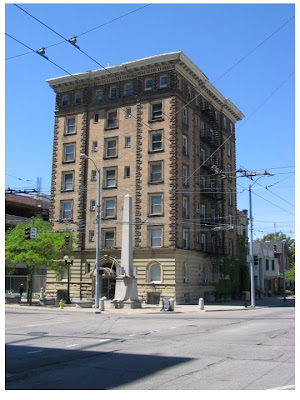The Asian Festival inspires this geographical look at cultural diversity and immigration in Dayton.
First this key map. Here I show some landmarks: rivers in blue, expressways (black lines), some surface streets (red lines), and various locations and landmarks. I recognize geography education is poor in the USA and people have trouble recognizing patterns on maps, so this is to help orient you, at least in a general sense.
I also include a part of Greene County here, but do not show county lines and city limits as I want to emphasis the Dayton metro area as a whole, as a system, getting away from a parochial POV.
I did have to sacrifice some coverage of both counties, but as you will see, for the purposes of this topic, we’ll still be able to capture the relevant geography.

In all the following maps I show only the higher concentrations. Asians, Latinos, and the foreign born are found throughout the area, but in lower numbers than I show here. Between 50% to 60% of the relevant populations are being mapped, the balance distributed throughout the two counties.
First, mapping Asians and Latinos by number (we saw the Asian map earlier).
The Asian population, which we’ve seen before, with substantial concentrations in Washington Township, the Springboro Pike corridor and the Beavercreek/Wright State areas.

There are about 8,909 Latinos in Greene and Montgomery counties who answered the census, which probably does not include the undocumented population. One can make a safe assumption that due to
chain migration effects the undocumented will live in the same tracts as those who responded to the census.
One can see how the Asian and Latino geographies overlap in suburbia, but also how Latinos are starting to concentrate along the Mad River/Route 4 corridor into Greene County, with a substantial urban population in east Dayton, particularly in Twin Towers, Huffman, Findlay Avenue & Springfield Street neighborhoods.

There is also a concentration in military housing at Wright-Patterson AFB and in the Fairgrounds/University of Dayton area.
Next I combine Asian and Latino populations, and express this number as a % of census tract population, perhaps as an indication of cultural diversity, showing which tracts have a higher % of non-white/non-black population, and map out the results for the top tracts.
Using this method tracts with small overall populations but even a moderate number of Asians + Latinos will have having a higher %, and large numbers in populous tracts will be diluted and appear as a low %,

Here one can see the concentration in the Fairfield Commons area as the highest concentration by far at 11.33%, followed by a concentration in base housing, Wright State/Colonel Glenn corridor, and the Springboro Pike corridor south of the Dayton Mall. There is also a concentration in a tract in northern Huber Heights, off the map.
The only substantial city concentration is in Twin Towers, plus a lower concentration north of E 3rd, east of Findlay.
Immigration & Foreign BornThe above maps count Asians and Latinos, but make no distinction if they are immigrants or not. And not all immigrants are Asian or Latino. The census counts 18,905 foreign born individuals in Montgomery and Greene Counties, and they could come from a variety of places, including the traditional immigration source of Europe. The numbers here are small, as we shall see.
Mapping out the numbers, one sees similar distribution as for the Asian and Latinos, but also slight concentrations to the north (including some tracts off the map), and a concentration between Wolf Road and N Main Street. Wright State area is again a leading tract, perhaps indicating that WSU is attracting foreign students.
The Twin Towers/Linden Heights area is the concentration in inner Dayton.

Mapping the percentage of a tract that is foreign-born. Again the Fairfield Commons area is one of the top tracts, along with McPhersontown, which didn’t appear in any of the previous maps. Perhaps the foreign born population in McPhersontown is not necessarily Latino or Asian?

Wright State area and a newer suburban tract in Greene County also have higher percentages.
Suburbia does seem to be a popular location for both Asians and Latinos as well as the foreign-born population (recognizing there is some overlap). Newer suburbia and edge-city areas seem to particularly favored.
The exception is for Latinos, with East & North Dayton (particularly the Twin Towers ) and a corridor heading east/northeast into Greene County, having concentrations.
It’s also interesting to see Moraine pop up a few times on these maps.


 Music starts at 1:00 PM, but get their early for a shade tree spot to spread your blanket or set up your lawn chairs
Music starts at 1:00 PM, but get their early for a shade tree spot to spread your blanket or set up your lawn chairs















































